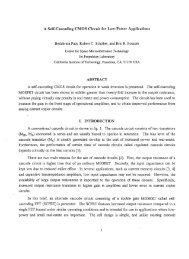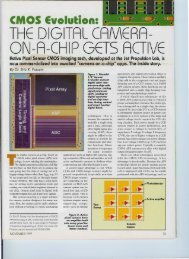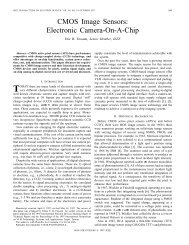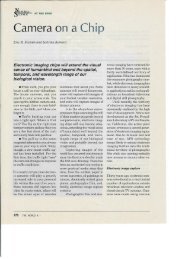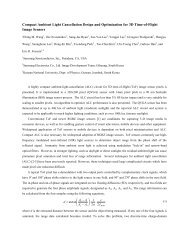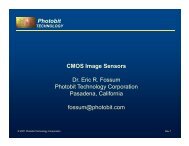Infrared readout electronics for space science sensors - Eric Fossum
Infrared readout electronics for space science sensors - Eric Fossum
Infrared readout electronics for space science sensors - Eric Fossum
Create successful ePaper yourself
Turn your PDF publications into a flip-book with our unique Google optimized e-Paper software.
6.5 Smart Focal-PlanesIncreasing the amount of on-focal-plane processing can, in principle, reduce the data transmission requirements of aremote <strong>space</strong>borne <strong>science</strong> sensor. In general, the <strong>science</strong> community is not appreciative of altering the raw detector arraysignal on the focal-plane [57]. However, some future spectroscopic mapping missions may benefit from integratingfeature extraction circuitry either in the instrument, or on the focal-plane itself to reduce deep <strong>space</strong> communicationsbandwidth requirements. Neural network circuits might be used efficiently on the focal-plane to recognize certain spectralsignatures and classify or tag particular data in order to reduce transmission bandwidth or initiate other higher levelfunctions. Such spectro-cognitive neuroprocessing <strong>for</strong> imaging spectrometers was recently proposed by JPL.Other "smart" functions that could be per<strong>for</strong>med on the focal-plane include event-driven <strong>readout</strong>, where the <strong>readout</strong> isdriven by the data itself, not by scanning circuits. Additional processing could include on-chip cosmic-ray circumvention,on-chip multiple sampling <strong>for</strong> read noise reduction, non-uni<strong>for</strong>mity correction and micromotion stabilization. The lattermight be achieved by integrating a fine guidance sensor function on same EPA as the detectors to actuate "adaptive" opticsor piezoelectric transducers.7. SUMMARYThis paper has attempted to summarize the major issues associated with infrared <strong>readout</strong> <strong>electronics</strong> <strong>for</strong> <strong>space</strong> <strong>science</strong><strong>sensors</strong>. For many mature JR detector technologies, it is now the <strong>readout</strong> <strong>electronics</strong> that limit scientific per<strong>for</strong>mancerather than the detector itself. The general requirements <strong>for</strong> scientific JR FPA <strong>readout</strong> <strong>electronics</strong> were discussed. Thestate-of-the-art has been reviewed <strong>for</strong> both circuit approaches and technologies. The paper has reviewed source-followerper detector, direct injection, buffered direct injection, gate modulation input, cascode amplifier per detector, andcapacitive transimpedance amplifier circuits. Noise reduction strategies were identified. Future directions <strong>for</strong> continuedR&D have been suggested.8. ACKNOWLEDGMENTSThe authors are grateful to their numerous colleagues <strong>for</strong> providing technical material <strong>for</strong> this paper including M.Blessinger, A. Hoffman, D. McCann, R. Kelchner, T. Lomheim, and R. Kirschman. In particular, the authors wish tothank L. Kozlowski of Rockwell <strong>for</strong> many useful discussions. The authors would also like to thank their colleagues at JPL<strong>for</strong> providing suggestions <strong>for</strong> the improvement of this manuscript. The authors appreciate the support of C. Stevens, M.Herring, and V. Sarohia of JPL, and G. Johnston of NASA HQ.The research described in this paper was carried out by the Center <strong>for</strong> Space Micro<strong>electronics</strong> Technology, Jet PropulsionLaboratory, Cali<strong>for</strong>nia Institute of Technology, under a contract with the National Aeronautics and Space Administration.Reference herein to any specific commercial product, process, or service by trade name, trademark, manufacturer, orotherwise, does not constitute or imply endorsement by the United States Government or the Jet Propulsion Laboratory,Cali<strong>for</strong>nia Institute of Technology.9. REFERENCES1. D. Scribner, M. Kruer, and J. Killiany, "<strong>Infrared</strong> focal-plane array technology," Proc. IEEE, vol. 79 (1), pp. 66-85(1991).2. P. Norton, "<strong>Infrared</strong> image <strong>sensors</strong>," Opt. Eng., vol. 30 (11), pp. 1649-1660 (1991).3. W. Kosonocky, "A review of infrared image <strong>sensors</strong> with schottky-barrier detectors," Optoelectron. Dev. and Tech.,vol. 6 (2), pp. 173-203 (1991).4. F. Low, "Unfulfilled needs in JR astronomy focal-plane <strong>readout</strong> <strong>electronics</strong>," in <strong>Infrared</strong> Readout Electronics, Proc.SPIE, vol. 1684, pp. 168-174 (1992).282 / SPIE Vol. 2020 <strong>Infrared</strong> Technology XIX (1993)



